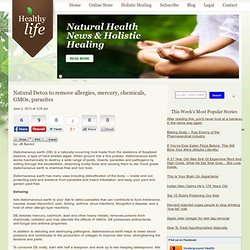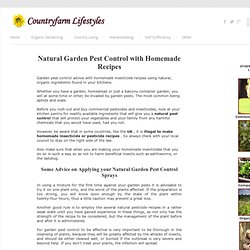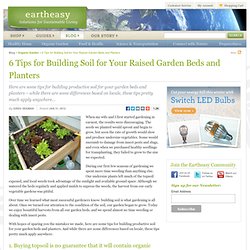

Natural Detox to remove allergies, mercury, chemicals, GMOs, parasites. Share by: JB Bardot Diatomaceous earth (DE) is a naturally occurring rock made from the skeletons of fossilized diatoms, a type of hard-shelled algae.

When ground into a fine powder, diatomaceous earth works mechanically to destroy a wide range of pests, insects, parasites and pathogens by cutting through the exoskeleton, absorbing bodily fluids and causing them to die. Food grade diatomaceous earth is chemical-free and non toxic. Diatomaceous earth has many uses including detoxification of the body — inside and out; protecting pets and livestock from parasites and insect infestation; and keep your yard and garden pest-free. Beginner’s Guide to Veganic Gardening. Vegan-organic gardening avoids not only the use of toxic sprays and chemicals, but also manures and animal remains.

Just as vegans avoid animal products in the rest of our lives, we also avoid using animal products in the garden, as fertilizers such as blood and bone meal, slaughterhouse sludge, fish emulsion, and manures are sourced from industries that exploit and enslave sentient beings. As these products may carry dangerous diseases that breed in intensive animal production operations, vegan-organic gardening is also a safer, healthier way to grow our food. Organic Pesticides, Homemade Pesticides and Insecticides for Natural Pest Control. Do you have anything that you would like to add after reading this page?

We would love to hear your thoughts. If you can add additional information to what has been written here you will be adding value to the website! No need to have any special skills - just type and submit. The Amazing Benefits of a Home Organic Aquaponics System. By Andy Whiteley Co-Founder of Wake Up World What is Aquaponics?

Aquaponics is an integrated aquaculture (growing fish) and hydroponic (growing soil-less plants) system that mutually benefits both environments. Aquaponics was essentially born out of hydroponics, which at the time made farming a lot easier. This process was associated with planting your veggies inside containers together with water. Thankfully, fertilizers and harmful chemicals are not required when setting up your own home organic aquaponics system.
The below video features U.S. farmer, Will Allen from Growing Power, who has taken successful Aquaponics cultivation to the extreme. Will Allen Talks Us Through Growing Power What are the Benefits Aquaponics? Up to 10 times more organic plants! With aquaponics you place plants closer together on a float system above the water, therefore it fits 10 times more plants in the same space! There’s no more weeding! The system removes the need for pain-staking and annoying weeding. Natural Revolution. FARMING: Growing Food & Raising Animals. Raised Beds: Preparing your Garden Beds for Spring. This may sound odd to you, but my favorite season in the garden is early spring, after our raised beds are prepared but before anything is growing.

The sight of the raised beds topped up with rich soil, moist and crumbly, free of weeds and ready to plant is a brief moment of perfection, full of promise, a blank canvas awaiting the gardener’s vision. When raised beds are well prepared, the hardest part of gardening is also done. And the better the garden beds are prepared, the less work there will be during the growing season, and the more likely the gardener’s vision will come to fruition. Here are some tips for preparing your raised beds for a bountiful growing season. Work from outside the beds. When gardening in raised beds, try to adhere to the one basic ‘ground’ rule: Don’t step on the soil within the raised beds. When you build or buy raised beds, be sure you’re able to reach every part of the bed without having to stand in it.
Turn under, or smother, green manure cover crops. 6 Tips for Building Soil for Your Raised Garden Beds and Planters. When my wife and I first started gardening in earnest, the results were discouraging.

The seeds we planted would sprout and begin to grow, but soon the rate of growth would slow and produce undersize vegetables. Some would succumb to damage from insect pests and slugs, and even when we purchased healthy seedlings for transplanting, they failed to grow to the size we expected. During our first few seasons of gardening we spent more time weeding than anything else. Our undersize plants left much of the topsoil exposed, and local weeds took advantage of the sunlight and available ground space. Although we watered the beds regularly and applied mulch to supress the weeds, the harvest from our early vegetable gardens was pitiful.
Over time we learned what most successful gardeners know: building soil is what gardening is all about. With hopes of sparing you the mistakes we made, here are some tips for building productive soil for your garden beds and planters. 1. 2. 3. 4. 5. GARDENING & GARDENS.